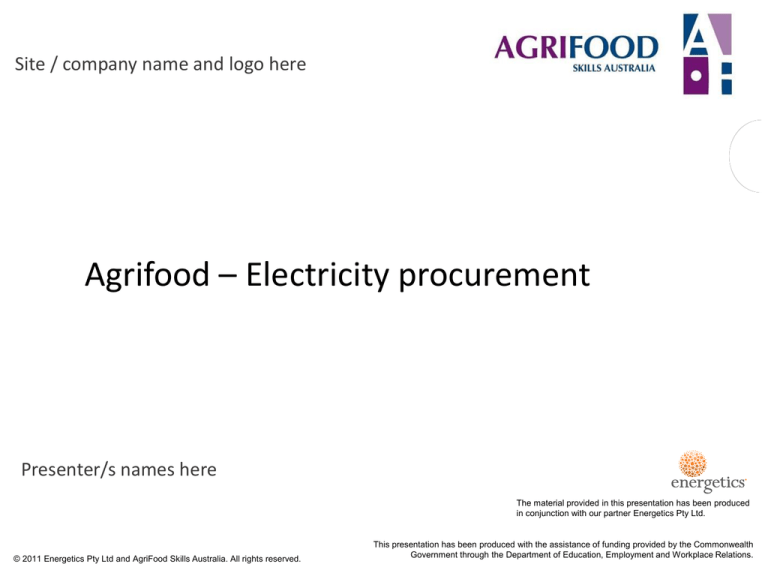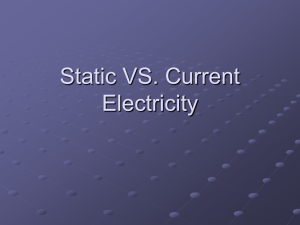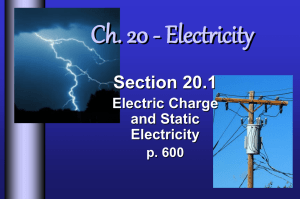
Site / company name and logo here
Agrifood – Electricity procurement
Presenter/s names here
The material provided in this presentation has been produced
in conjunction with our partner Energetics Pty Ltd.
© 2011 Energetics Pty Ltd and AgriFood Skills Australia. All rights reserved.
This presentation has been produced with the assistance of funding provided by the Commonwealth
Government through the Department of Education, Employment and Workplace Relations.
Overview of Energy Markets
Deregulation
Deregulation process – electricity
• Commenced from 1994, with the largest sites first
– Purpose was to promote competition in retail and generation sectors,
allow users to choose a retailer, and increase efficiency
• Single Generation, Network and Retail companies were
separated into separate entities
– Generators and retailers set their prices via the market, network
providers’ prices continued to be regulated
• For customers, deregulation means:
–
–
–
–
The right to choose who supplies your electricity invoices
No change to network provider
Small sites typically retain bundled billing
Large sites on contract move to unbundled billing
National Electricity Market (NEM)
• National Electricity Market
established in 1998 to facilitate
deregulation.
• Electricity can physically flow
between states.
• Each state has separate markets
where generators can sell their
output and retailers can buy their
demand.
– Prices set by supply and demand
• WA electricity market and billing
differs significantly to the NEM
Source: AEMO SOO 2009
Deregulation status – electricity
State
Started
Deregulation
Current Status
ACT
1997
Fully Deregulated
NSW
1996
Fully Deregulated
QLD
1998
Fully Deregulated
SA
1998
Fully Deregulated
VIC
1994
Fully Deregulated
NT
2000
Deregulated to
750MWh
TAS
2006
Deregulated to
150MWh
WA
1997
Deregulated to
50MWh
Example: www.eriu.energy.wa.gov.au/3/3122/3073/contestability_.pm
Deregulation status – natural gas
For natural gas customers:
–
–
–
–
–
All states except NT have contestable natural gas supply
Tasmania and NT have very limited gas networks
No change to network provider if you move retailers
Small sites typically retain bundled billing
Large sites on contract move to unbundled billing
For all energy supplies, you can always discuss with your supplier whether
your account is ‘contestable’
Electricity spot and futures markets
• Electricity bought and sold in the NEM is via a central pool
• The Australian Energy Market Operator (AEMO) selects the
lowest cost combination of generator offers to meet demand
• The highest priced accepted offer sets the half hourly Spot Price,
with this price received by all dispatched generators
• Shortage in supply v demand forces spot prices up, and vice versa
• Spot prices range -$1,000 to $12,500/MWh as of July 2010
• To mitigate the risk of fluctuating spot market prices a secondary
‘futures’ market has developed, which predicts spot prices for a
given period in the future
• Generators and Retailers can use the Futures Market to agree a
fixed price to trade electricity, which increases certainty
Key Points from Section
• Deregulation provides a choice of supplier, but not of network
provider
• NEM is a wholesale electricity market and interconnected
supply network for ACT, NSW, Qld, SA, Tas & Vic
• Spot prices are set to clear supply and demand every 30mins
• Futures prices are projections of what the average spot price
will be in a later period
Electricity Invoices
Formats and Components of Electricity
Billing
System components
Generator
Transmission lines
Distribution lines
Retailer
AEMO
Financial flows
Physical flow of power
End users
Electricity Supply Chain
MAKES THE PRODUCT - ELECTRICITY
GENERATION
TRANSMISSION
DISTRIBUTION
RETAILER
CUSTOMER
Costs included in Energy Charges
DELIVERS THE PRODUCT TO THE SYSTEM
Regulated & Passed on to Retailer via Network Charges
DELIVERS THE PRODUCT TO THE CUSTOMER
Owns the Poles and Wires. Regulated Network Charges.
SELLS THE PRODUCT TO THE CUSTOMER
Manages Risk & Bundles Charges.
THE END USER
Uses the electricity & pays the retailer
Delivered electricity costs
ELECTRICITY COST COMPONENTS
5%
3% 2% 0%
30%
60%
Energy
Losses
Network
Market Fees
Environmental
Metering
Typical bundled invoice small sites
Individual Cost Elements Not
Identified On Bill
Typical unbundled invoice large sites
Generator
Contestable.
Prices vary by
supplier.
Transmission lines
Distribution lines
NonContestable.
Prices vary by
location.
NonContestable.
Prices vary by
state.
Market Manager
Contestable.
Prices vary
by supplier.
AEMO
Meter Agent
Bundled v Unbundled
• Typical sites on bundled billing:
– Sites that have remained on franchise tariffs.
– Domestic supplies
– Small contract electricity supplies (<$25k annual spend)
• Typical sites on unbundled billing
– Large contract electricity supplies
Charge components
•
•
•
•
•
Energy – generator, retail margin
Network – transmission + distribution
Market – NEM fees
Metering – fee for each metering point
Environmental – renewable energy, retailer obligation scheme
pass-through fees
Energy Charges
• Account for the physical commodity used by the customer
• Largest negotiable cost element
• Quoted and charged in $/MWh or c/kWh
– For large sites, prices usually split into Peak and Off Peak periods (plus
a shoulder period in ACT and NSW).
• Contract rates will be escalated by losses when invoiced
• Determined by the underlying futures market prices when
contracting
Losses
•
•
•
•
•
•
•
•
Energy lost between generation and the point of use
Expressed as a percent (e.g. 4.8%) or a factor (e.g. 1.048)
Only apply on unbundled pricing arrangements
Will cause your billed rates to differ from your contract rates
Energy rates escalated by DLF and TLF multiplied together
Environmental and market charges escalated by DLF only
Network and metering charges are not impacted by losses
Updated annually from 1 July by the Australian Energy Market
Operator and published on their website
– So, from 1 July your billed rates may change, even if your contract
rates haven’t!
Environmental Charges
• Federal and State Government schemes
• Allow retailers to pass on the costs of meeting legislated
environmental schemes to the end user
• Are a negotiable element of your contract/billing
– Differences between retailers’ enviro prices can be greater than the
differences between their energy prices
– Important to analyse combined energy and enviro rates when
comparing retailer offers
• Are escalated on bills by the Distribution Loss Factor
• Depending on the State, enviro charges will form around 410% of total bill costs
• If you don’t request firm enviro prices, your retailer will
usually amend prices during the contract to follow market
movements
Network Charges
• Covers the ‘poles and wires’ costs
• Passed through at cost by your electricity supplier
• Charge structures are designed to incentivize customers to
use electricity in a way that relieves stress on the supply
network – e.g. peak/offpeak rates, kVA demand charges
• Prices fully regulated and set annually (usually)
• Most network providers give the customer several choices of
network tariff. The lowest cost option can be selected
• Typically form 30-50% of bill costs depending on site location
and type of usage
– This proportion is increasing due to significant investment
requirements across the networks
– For example, NSW network prices increased by around 20% from 1
July 2010
Market Charges
• Costs applied by the Australian Energy Market Operator for
running the market
• Retailers can recover AEMO’s costs from the customer by
passing through charges on invoices
• Two charges which change each 1 July:
– AEMO Ancillary Services Fee
– AEMO Market Participation Fee
• Both charges will usually amount to <1% of total bill cost, and
are non-negotiable, so significant management is not merited
Metering Charges
• Covers the costs of installing and maintaining a site’s
electricity meter, as well as recording and processing usage
data
• Is a negotiable charge element:
• Customers can contract directly with a metering provider and ask
retailer to pass through costs; or
• If the Customer does not nominate a metering provider, the retailer
will appoint one on the customers behalf.
• Typically, a saving of $100-200/per meter per annum (10%20%) can be made under option 1
• Advantages of Contracting Directly with a Metering Provider:
•
•
•
•
•
Typically lower metering charges
Direct access to online metering data
Usage alarms (high demand etc)
Linking other utilities for reporting (water, gas)
Loss of supply notification
GreenPower
• Some customers choose to make a voluntary purchase of
electricity generated from renewable sources
• “GreenPower” is the Federal Government’s renewable energy
program
• Purchasing GreenPower is purely a ‘bolt-on’ purchase
– There is no alteration to your physical supply of electricity
– GreenPower and electricity purchases can be ‘decoupled’ and bought
through different providers
Key Points
• The Futures Market is the main driver of energy contract rates
• Network charges are regulated, but savings can often be
made by switching tariffs
• Losses apply to energy, environmental and market charges
• Environmental charges are separately negotiable
• Metering services can be contracted separately and passed
through
Contracting Principles
Types of Contract
Decreasing budget certainty, but potentially higher reward
1. Fixed price fixed volume forward contracting
2. Flexible forward purchase of variable volume
3. Fixed block purchase (e.g. with generator) with partial pool exposure
4. Portfolio purchase of fixed volume (partial pool exposure)
5. Managed pool exposure with active demand management or
financial cover
6. Pool price pass-through
Over 95% of contract customers use Option 1
What does a contract cover?
• Energy price and quantity
• Contribution to mandatory environmental obligations (RECs,
NGACs, GECs etc)
• Metering (optional)
• Account management
• Billing
Not:
• Delivery of energy
• Security of supply
• Regulated charges
• Losses
Option 1–Fixed Price Fixed Volume
MW
Demand
Retailer carries volume risk (within +/- 10% of nominated
annual volume) as well as risk of demand fluctuations.
Actual Demand
2011
360 GWh
annual
volume +/36 GWh.
2011
2012
370 GWh
annual
volume +/37 GWh.
2012
Fully positioned for 2011 & 2012
electricity requirements
Need to buy for 2013 onwards
2013
2014
2015
Option 1–Fixed Price Fixed Volume
• Customer agrees to buy from retailer for fixed price for a set
term
– “Standard” form of electricity contract
Advantages
Disadvantages
All market risk is on retailer – no exposure
to rising market prices.
No benefits will be received if market
prices fall during the contract.
Standard form of contract with low
ongoing maintenance.
Little flexibility should your requirements
change mid-contract.
Price certainty – retail elements of an
invoice will not change from the agreed
rates.
Contract Options
• Majority of customers seek a fixed price-fixed volume contract
• Key Features:
– Customer nominates annual energy usage for each contract year
– Retailer provides fixed energy rates (and enviro rates if requested) for
each contract year
– Customer is permitted to use, typically, between 90% and 110% of the
nominated annual volume at the agreed rates
• Usage outside these bounds may incur penalties
– No limits on demand
– Network and market charges are passed through on billing
Issues to consider when contracting
• Timing
– Vital in a volatile market
• Approvals process
• Duration of contract sought
•
•
•
•
– Short term (e.g. 12 month) contracts for new supplies to allow load
profiles to be built
Volume & site roll-in/roll-out
Environmental charges (RECs, GECs, NGACs and NRECs)
Option of franchise prices for new supplies in Queensland
Additional account services – are services such as electronic
billing and data provision required?
• Voluntary GreenPower
Procurement Process–Timing &
Approvals
• Prices can vary significantly on a daily basis
– Prepare to go to market at short-notice and take advantage of price
dips
– Important to streamline the procurement process in a volatile
market
– Reduce the offer validity period as much as possible in order to
lower the retailer’s risk premium and maximise the likelihood that
the offer is still available when accepting prices.
• A $1/MWh market movement equates to a cost change of
$50,000 per annum for a 50 GWh supply
Minimising the increase
• There are a few steps that clients can take to minimise the
impact of increasing electricity costs when seeking a fixedprice fixed-term contract:
– Maximise retailer participation
Keep things simple
– Provide detailed and accurate data, including information about
future changes where known
– Don’t include unreasonable requests
– Keep to the project timetable
– Prepare for internal sign-off
– Make a quick decision
Minimising the increase – making a
quick decision
• Historically, retailer offers have been valid for acceptance
for two weeks.
– This is no longer possible in a volatile market.
– Reducing validity period reduces risk premium that retailers will
add into pricing
• Who needs to sign off on the contract?
– How available are they?
– How can we help prepare them so that when the time comes
they are happy to approve the deal?
– What information will they need?
Post-contract review
• A lot of time goes into agreeing an electricity contract
• Vital to undertake post contract reviews into:
– Bill checking
• Do billed rates match contract rates?
• Are network costs passed through correctly?
– Load variance
• Are sites within the permitted usage variance?
– Is the supplier delivering everything they committed to?
• Reports, notifications etc.
Key Points
• Fixed-price fixed-term contracts are the ‘vanilla’ form of
agreement
• Timing of going to market is vital
• Be ready to act quickly to take advantage of market price
drops
• Streamline tendering processes
Opportunities for Savings
Steps to assessing savings
• Identify your site-type
Assess opportunities for:
• Switching franchise tariffs (if applicable)
• Moving to contract
–
•
•
•
Evaluate risks and opportunities in contracting separately for energy,
enviro and metering
Switching network tariffs
Power factor correction, if your site is on a kVA-demand
tariff
Validate invoices
Minimising energy charges
• Agree contract rates when the market price is low
– Easier said than done!
– Monitor market prices and don’t rely on the market being
attractive 1 month before your existing agreement expires
• Provide historic meter data and forecast load changes to
suppliers when requesting prices
– Reduces risk premium in pricing
• Do not include unnecessary requests in your
tender/contract, as you will usually pay for them
• Demand Side Management network providers and
retailers are often prepared to pay you if you are able to
curtail demand at short notice
Minimising network charges
• Select the lowest cost available published tariff
– Tariffs published on network providers’ websites
– Tariff change applications can be made via your retailer
• Monitor power factor on sites with a kVA-demand
• Where possible, look to shift load into off peak (or shoulder)
periods and minimise maximum demands
Site-specific data
• Insert details of current energy contracts, highlighting
peak/offpeak rates, negotiated components, overrun or
excess charges incurred, expiry dates
Site-specific data
• Insert copies of site energy bills, highlighting relevant
components
Site-specific data
• Insert interval data charts obtained from your retailer and/or
from your baseline analysis
2,500 kVA
01/06/2010
02/06/2010
2,000 kVA
03/06/2010
04/06/2010
1,500 kVA
05/06/2010
06/06/2010
1,000 kVA
07/06/2010
08/06/2010
09/06/2010
500 kVA
10/06/2010
11/06/2010
00:30
01:30
02:30
03:30
04:30
05:30
06:30
07:30
08:30
09:30
10:30
11:30
12:30
13:30
14:30
15:30
16:30
17:30
18:30
19:30
20:30
21:30
22:30
23:30
0 kVA
12/06/2010










